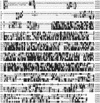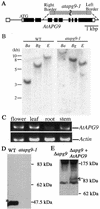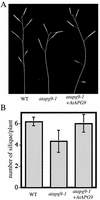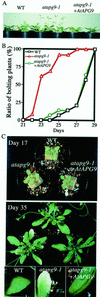Leaf senescence and starvation-induced chlorosis are accelerated by the disruption of an Arabidopsis autophagy gene
- PMID: 12114572
- PMCID: PMC166512
- DOI: 10.1104/pp.011024
Leaf senescence and starvation-induced chlorosis are accelerated by the disruption of an Arabidopsis autophagy gene
Abstract
Autophagy is an intracellular process for vacuolar bulk degradation of cytoplasmic components. The molecular machinery responsible for yeast and mammalian autophagy has recently begun to be elucidated at the cellular level, but the role that autophagy plays at the organismal level has yet to be determined. In this study, a genome-wide search revealed significant conservation between yeast and plant autophagy genes. Twenty-five plant genes that are homologous to 12 yeast genes essential for autophagy were discovered. We identified an Arabidopsis mutant carrying a T-DNA insertion within AtAPG9, which is the only ortholog of yeast Apg9 in Arabidopsis (atapg9-1). AtAPG9 is transcribed in every wild-type organ tested but not in the atapg9-1 mutant. Under nitrogen or carbon-starvation conditions, chlorosis was observed earlier in atapg9-1 cotyledons and rosette leaves compared with wild-type plants. Furthermore, atapg9-1 exhibited a reduction in seed set when nitrogen starved. Even under nutrient growth conditions, bolting and natural leaf senescence were accelerated in atapg9-1 plants. Senescence-associated genes SEN1 and YSL4 were up-regulated in atapg9-1 before induction of senescence, unlike in wild type. All of these phenotypes were complemented by the expression of wild-type AtAPG9 in atapg9-1 plants. These results imply that autophagy is required for maintenance of the cellular viability under nutrient-limited conditions and for efficient nutrient use as a whole plant.
Figures








Similar articles
-
Autophagy machinery controls nitrogen remobilization at the whole-plant level under both limiting and ample nitrate conditions in Arabidopsis.New Phytol. 2012 May;194(3):732-740. doi: 10.1111/j.1469-8137.2012.04084.x. Epub 2012 Mar 9. New Phytol. 2012. PMID: 22404536
-
Processing of ATG8s, ubiquitin-like proteins, and their deconjugation by ATG4s are essential for plant autophagy.Plant Cell. 2004 Nov;16(11):2967-83. doi: 10.1105/tpc.104.025395. Epub 2004 Oct 19. Plant Cell. 2004. PMID: 15494556 Free PMC article.
-
A tissue-specific rescue strategy reveals the local roles of autophagy in leaves and seeds for resource allocation.Plant Physiol. 2024 Dec 23;197(1):kiae647. doi: 10.1093/plphys/kiae647. Plant Physiol. 2024. PMID: 39661375 Free PMC article.
-
Autophagy in development and stress responses of plants.Autophagy. 2006 Jan-Mar;2(1):2-11. doi: 10.4161/auto.2092. Epub 2006 Jan 9. Autophagy. 2006. PMID: 16874030 Review.
-
Leaf senescence.Annu Rev Plant Biol. 2007;58:115-36. doi: 10.1146/annurev.arplant.57.032905.105316. Annu Rev Plant Biol. 2007. PMID: 17177638 Review.
Cited by
-
Cytoplastic Glyceraldehyde-3-Phosphate Dehydrogenases Interact with ATG3 to Negatively Regulate Autophagy and Immunity in Nicotiana benthamiana.Plant Cell. 2015 Apr;27(4):1316-31. doi: 10.1105/tpc.114.134692. Epub 2015 Mar 31. Plant Cell. 2015. PMID: 25829441 Free PMC article.
-
Autophagy-Related 2 Regulates Chlorophyll Degradation under Abiotic Stress Conditions in Arabidopsis.Int J Mol Sci. 2020 Jun 25;21(12):4515. doi: 10.3390/ijms21124515. Int J Mol Sci. 2020. PMID: 32630439 Free PMC article.
-
Abscisic Acid-Triggered Persulfidation of the Cys Protease ATG4 Mediates Regulation of Autophagy by Sulfide.Plant Cell. 2020 Dec;32(12):3902-3920. doi: 10.1105/tpc.20.00766. Epub 2020 Oct 9. Plant Cell. 2020. PMID: 33037147 Free PMC article.
-
Hydrogen sulfide reduces cell death through regulating autophagy during submergence in Arabidopsis.Plant Cell Rep. 2022 Jul;41(7):1531-1548. doi: 10.1007/s00299-022-02872-z. Epub 2022 May 4. Plant Cell Rep. 2022. PMID: 35507055
-
Identification and characterization of two rice autophagy associated genes, OsAtg8 and OsAtg4.Mol Biol Rep. 2006 Dec;33(4):273-8. doi: 10.1007/s11033-006-9011-0. Epub 2006 Nov 3. Mol Biol Rep. 2006. PMID: 17082902
References
-
- Aubert S, Gout E, Bligny R, Marty-Mazars D, Barrieu F, Alabouvette J, Marty F, Douce R. Ultrastructural and biochemical characterization of autophagy in higher plant cells subjected to carbon deprivation: control by the supply of mitochondria with respiratory substrates. J Cell Biol. 1996;133:1251–1263. - PMC - PubMed
-
- Chen MH, Liu LF, Chen YR, Wu HK, Yu SM. Expression of alpha-amylases, carbohydrate metabolism, and autophagy in cultured rice cells is coordinately regulated by sugar nutrient. Plant J. 1994;6:625–636. - PubMed
-
- Chirgwin JJ, Przbyla AE, MacDonald RJ, Rutter WJ. Isolation of biologically active ribonucleic acid from sources enriched in ribonuclease. Biochemistry. 1979;18:5294–5299. - PubMed
Publication types
MeSH terms
Substances
Associated data
- Actions
LinkOut - more resources
Full Text Sources
Molecular Biology Databases

